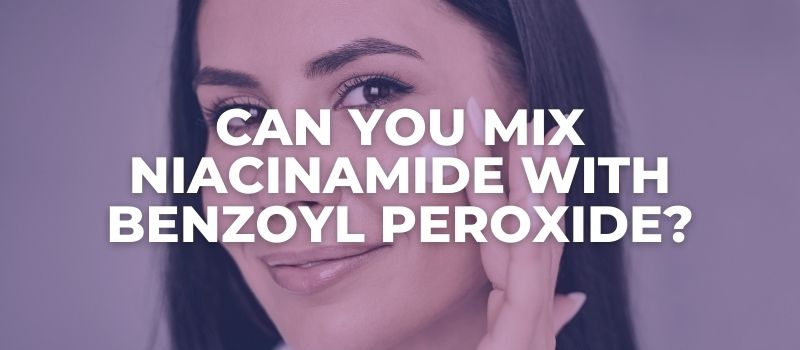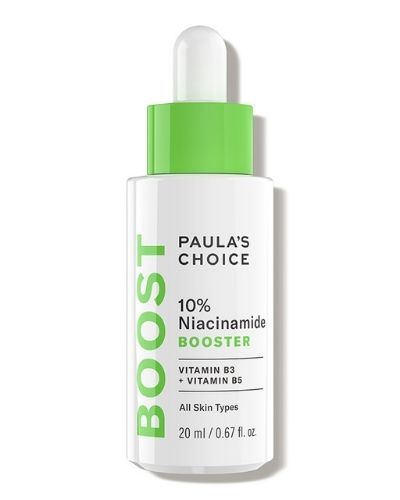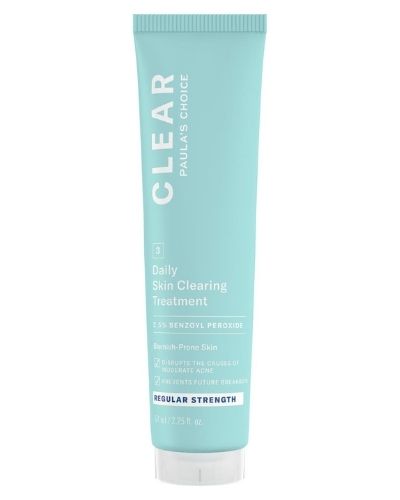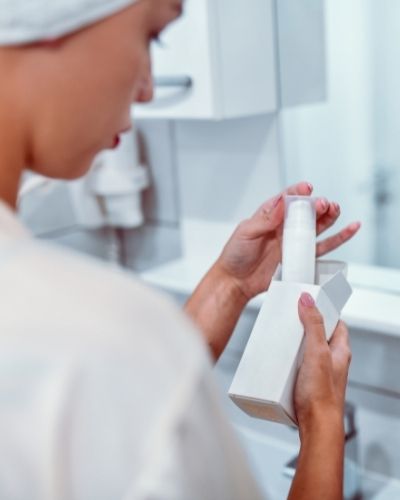Yes, you can mix niacinamide with benzoyl peroxide, and in fact, this combination can help improve skin issues such as excessive oiliness, inflammation, and acne, as well as some mild hyperpigmentation.
However, even though these two actives are relatively easy to use and tolerate, you still need to be aware that potential side effects may occur.
Therefore, in this article, we will talk about the benefits and risks of using niacinamide and benzoyl peroxide together as well as how to properly combine them for best results and no unwanted reactions.

How Does Niacinamide Work?

Otherwise known as vitamin B3, niacinamide is one of the most potent anti-inflammatory ingredients in skincare products.
But vitamin B3 is also an essential nutrient for your body as there have been reports that suggest vitamin B3 deficiency can lead to disorders of the skin, kidneys, and brain.
While topically applied niacinamide won’t do anything for your kidneys and brain function, it can still help balance the skin function and prevent some inflammatory conditions.
Niacinamide is ideal for treating blemishes due to its anti-inflammatory properties and can suppress the skin’s inflammatory response to calm redness, sores, and imperfections.
Niacinamide also encourages the production of ceramides which are an important part of a strong skin barrier and are needed to prevent moisture loss and irritation.
Lastly, niacinamide inhibits melanosome transfer from melanocytes (pigment-producing cells) to keratinocytes (skin cells), which means it will stop the uneven deposition of pigment on a cellular level and eventually help brighten the already existing hyperpigmentation on the surface of the skin.
Some benefits of using niacinamide include:
- Balanced oil production.
- Normalized skin function.
- Less inflammation and irritation on the skin.
- Improved acne breakouts.
- Hydration and softness.
RELATED: 10 Best Niacinamide Serums Under $30.
How Does Benzoyl Peroxide Work?

Benzoyl peroxide is one of the most common ingredients in skincare products designed to combat acne breakouts, and it is often found in cleansers, gels, and creams.
It’s an industrial chemical that belongs to the peroxide family of chemicals that has been used in medicine for nearly a century.
Benzoyl peroxide has small molecules that travel deeper into the skin and carry oxygen in the pores to destroy the airless environment where acne-causing bacteria thrive.
However, although benzoyl peroxide is an amazing acne-fighting chemical, it’s best to incorporate it into your routine sparingly and slowly minimize use before eventually stopping it when acne is significantly reduced.
This is how you will give the healthy bacteria a chance to balance itself out and become commensal (neutral) or even useful for your skin instead of hostile towards its environment.
Some benefits of using benzoyl peroxide include:
- It has a quick action against acne.
- It is fairly well tolerable by all skin types, including sensitive skin.
- It’s affordable and easily accessible to everyone.
RELATED: Can You Mix Salicylic Acid with Benzoyl Peroxide?
Benefits of Using Niacinamide With Benzoyl Peroxide
Both niacinamide and benzoyl peroxide are useful against acne.
When using them together to address this particular condition, niacinamide will be the ingredient that’ll balance out oil production, strengthen the skin barrier, and minimize inflammation, while benzoyl peroxide will oxygenate the pores and help destroy the overgrowth of the acne bacteria.
How to Use Niacinamide With Benzoyl Peroxide?
When using niacinamide with benzoyl peroxide, it’s best to opt for products that contain a low concentration of both ingredients.
This is how you will avoid irritating your skin with strong actives and achieve better results than you would by nuking your barrier with the highest possible strength of both actives.
It’s also important to note that you should always watch out for signs of irritation.
Although both ingredients are safe and relatively well-tolerated by all skin types, you shouldn’t exclude the possibility of irritation that can occur by overusing these actives.
Therefore, alongside using low concentration products, it’s also best to use them in the evenings with a day or two break in between.
As for the order of using them, it doesn’t really matter, and you can layer them according to the general rule of “thinner to thicker consistency.”
You can also use a benzoyl peroxide treatment after cleansing and follow it up with a moisturizer that contains niacinamide, such as EltaMD PM Therapy Facial Moisturizer or CeraVe PM Oil-Free Moisturizer.
This is my favorite way of incorporating both actives in my skincare routine because I get a little bit of both with no risk of irritation.
Risks of Mixing Niacinamide With Benzoyl Peroxide

As with any other active ingredient, the risk of potential irritation is present when mixing niacinamide with benzoyl peroxide.
Bear in mind that if a reaction occurs, it will most probably be due to the strength of both products.
For example, the risk of irritation or any other side effects such as peeling and dryness would be much smaller if you use a mild strength benzoyl peroxide, such as 2.5%, instead of going for 5% or 10%.
Additionally, although beneficial, niacinamide is also an active ingredient that should be used with caution, especially if the product contains a high concentration of it, such as the Paula’s Choice Clinical 20% Niacinamide Treatment.
Bear in mind that niacinamide is an active that has been proven to work in concentrations as low as only 4%, so anything above that is unnecessary and will put your skin at risk of irritation.
Benzoyl peroxide is also an active that works extremely well at low concentrations of only 2.5%, so again, anything above that will increase your risk of irritation, dryness, and sensitivity.
If you start experiencing symptoms such as redness, irritation, dryness, sensitivity, and unusual reaction to other products, it’s best to minimize the use of both actives and give your skin some time to repair and strengthen before reintroducing them slowly into your routine.

My name is Simone and I am a certified skin specialist. I created this website to teach my readers how to take great care of their skin and I also like to occasionally share my honest opinions on skincare products I’ve tried. You can learn more about me here.
